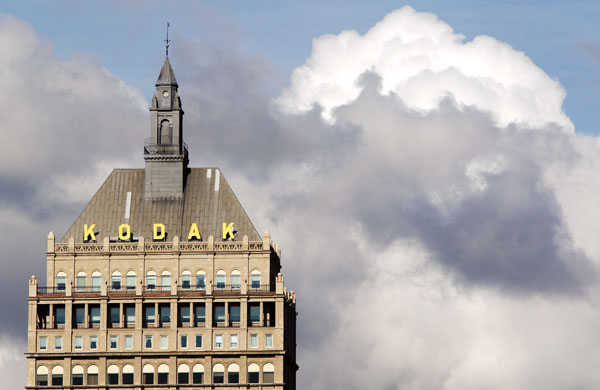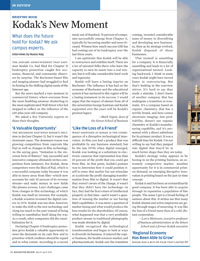In Review
 OPTIMISTIC VIEW: “I am optimistic that Kodak will be able to restructure and redefine itself,” says Simon School Dean Mark Zupan. “But it will take considerable hard work and ingenuity.” (Photo: Adam Fenster)
OPTIMISTIC VIEW: “I am optimistic that Kodak will be able to restructure and redefine itself,” says Simon School Dean Mark Zupan. “But it will take considerable hard work and ingenuity.” (Photo: Adam Fenster)The January announcement that Eastman Kodak Co. had filed for Chapter 11 bankruptcy protection caught few economic, financial, and community observers by surprise. The Rochester-based film and imaging pioneer had struggled to find its footing in the shifting digital sands of the Internet age.
But the news marked a rare moment in commercial history where everyone from the most fumbling amateur shutterbug to the most sophisticated Wall Street whiz kid stopped to reflect on the influence of the 120-plus-year-old company.
We asked a few University experts to share their thoughts.
‘A Valuable Opportunity’
The recession hastened Kodak’s decision to declare Chapter 11, but it wasn’t the dominant cause. The dominant reason was growing competition from copycats like Fuji as well as changes in film technology. As the saying goes, “Imitation is the sincerest form of flattery.” Any successful and innovative company ultimately invites competition from imitators. For Kodak, these competitors were the likes of Fuji, which is a successful company today because it was able to move away from film—which now accounts for only 10 percent of its revenue stream—and make money in new fields like plasma screens. Later challenges came from changes in film technology, of which Kodak was itself an inventor. For example, a Kodak scientist invented the digital camera in 1976. Kodak was too slow, however, to make the shift to the new technology and clung too much to the past instead of being willing to cannibalize itself along the way. As a result, other companies did the cannibalization for it.
Declaring Chapter 11 bankruptcy protection gives Kodak a valuable opportunity to reset the demands on its cash flow and to prioritize which creditors should be repaid and to what extent. According to a recent study out of Stanford, 76 percent of companies successfully emerge from Chapter 11, typically by becoming smaller and more focused. Witness how much success GM has had coming out of its bankruptcy over the last three years.
I am optimistic that Kodak will be able to restructure and redefine itself. There are a lot of talented folks there who have the capacity to turn its assets into a real winner, but it will take considerable hard work and ingenuity.
Kodak will leave a lasting imprint on Rochester. The influence it has had on the economy of Rochester and the educational system it has nurtured in this region will be a lasting testament to its success. I would argue that the impact of alumni from all of the universities George Eastman and Kodak supported over the years will be Kodak’s greatest legacy.
—Mark Zupan, dean of the Simon School of Business
‘Like the Loss of a Friend’
What happened at Kodak is the consequence of a disruptive technological innovation. In film, you had a product that was profitable by any business standard, but by the late 1970s when digital emerged, Kodak was looking at a substitute in electronic cameras that represented less than 10 percent of the profit that you could get from film. At that point, Kodak’s posture was to determine how it could position itself to enter that market but not stimulate or accelerate the profit-damaging transformation from film to digital. It wasn’t that they weren’t aware of the change, it wasn’t that they didn’t have the technology—in fact, they had the lion’s share of intellectual property at that time—and it wasn’t a question of missing the market or not having R&D capabilities. It was more a question of market timing and what would produce the best results for the shareholders. Of course, what happened was that a very profitable product stream in traditional photography was made obsolete by digital.
Kodak recognized the technological transformation and began to look at ways to diversify its business. It entered the copier business, the health sciences market, and pharmaceuticals. Kodak saw the transition coming, invested considerable sums of money in diversifying and developing new businesses, then as its strategy evolved, Kodak disposed of those businesses.
That turmoil is unsettling for a company. It is financially unsettling and leads to a lot of organizational turmoil. Looking backward, I think in some cases Kodak might have moved faster in restructuring. But that’s looking in the rearview mirror. It’s hard to say they made a mistake. I don’t know of another company that has undergone a transition as traumatic. It’s a company based on organic chemistry, that has a terrific brand, and here comes electronic imaging—low profitability, doesn’t use organic chemistry or Kodak’s manufacturing capability, and it’s presented with a direct substitute for its primary product. It was a difficult time for Kodak. I’m not willing to say had they jumped into digital that they’d be in much better shape than they are today.
Kodak’s strategy today appears to be honing in on the printing business, an extremely competitive market. Another opportunity for it is in commercial print-on-demand, an emerging disruptive innovation in printing based on the just-in-time concept.
Kodak is and has been an extraordinarily good company. It has been able to acquire through its reputation a population of fine people. The sense I get is a broad feeling of sadness about this. It strikes me that many Kodak alumni and active employees are going through stages of mourning. It was like the loss of a friend more than of a cold, distant corporation.
—Larry Matteson, executive professor of business administration at the Simon School and a former Kodak executive
‘Regional Economy Has Been Able to Grow’
Kodak had a run on film that lasted 90 years. When you have a product that’s so successful for so long, you have a classic example of creative destruction. How do you destroy something that’s been your lifeblood and pick up something (like digital technology) that destroys your business? The gross margin of film is enormously high compared to digital. If I were a manager at Kodak in the 1980s and we had a gross margin that high, why would I even think about doing digital? You’ve got to have a certain amount of vision to be able to look out on the horizon and realize what’s coming.
We were in denial in this community for a good 10 years about Kodak. Community leaders didn’t get on board until 20 years later, they didn’t say we have to restructure our economy or consider doing business in a different way. People just thought, “Don’t worry, Kodak’s going to come back.” If you’re in a slide for 20 years, with decreasing employment every year, somebody should have looked at this and thought about how we’re going to restructure our economy.
Kodak’s decision to file Chapter 11 had a relatively minor effect on the regional economy because most of the jobs were already gone. The impact was psychological rather than real.
Kodak has given Rochester tremendous potential in attracting a workforce with good education and skills and providing that workforce with good benefits. Its retirement program was quite generous, enough that people could start new businesses if they chose. And its workforce was well educated. Rochester didn’t have the same problem that, say, Buffalo or Akron or another rust belt city had, where many people who were laid off had only a high school education.
Fortunately, our regional economy has been able to grow during Kodak’s downsizing. Rochester created 12,000 jobs last year. We have some big successes like Paychex as well as in telecom, optics, and photonics. And we are incredibly diverse in terms of small businesses—we have many companies under 100 people. We’re never going to see a Kodak-size company here again. We’re more into hitting singles and doubles. We’re not trying to hit home runs. That’s good because no matter what industry is up or down, it’s not going to ruin the entire economy.
It takes about 20 years to transition an economy; it takes a generation of people to go through the system. You have to have a clear vision of where you’re going, foster entrepreneurship and diversity, and build a community that celebrates the arts. We’re five to seven years into that 20-year transition.
—Duncan Moore, vice provost for entrepreneurship and the Rudolf and Hilda Kingslake Professor of Optical Engineering
Husna Haq is a Rochester-based freelance writer.

